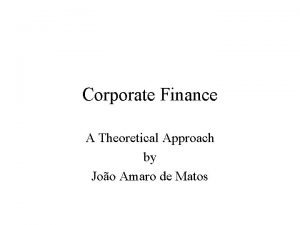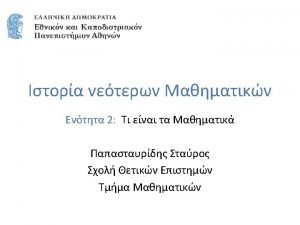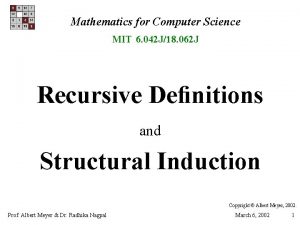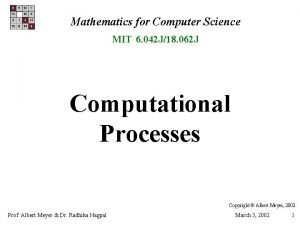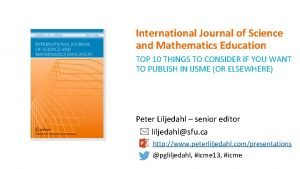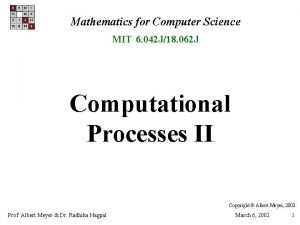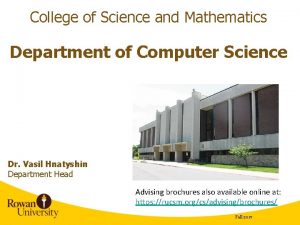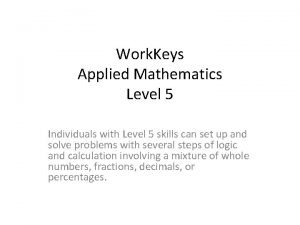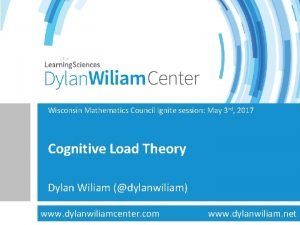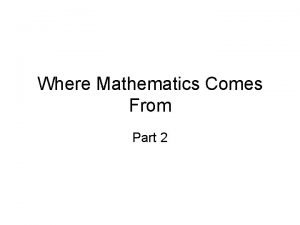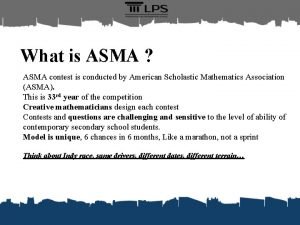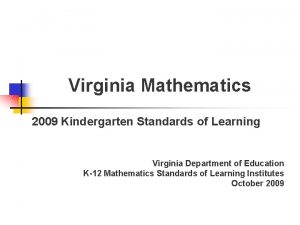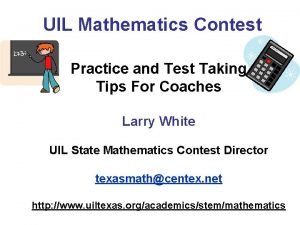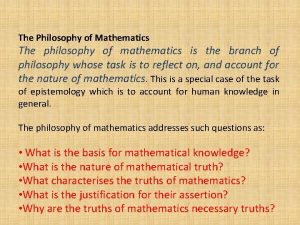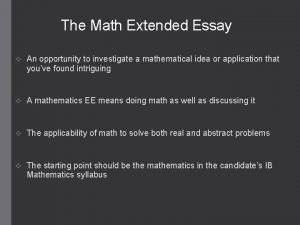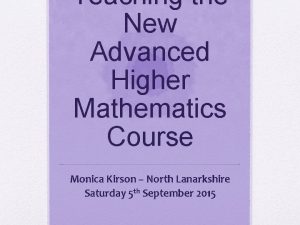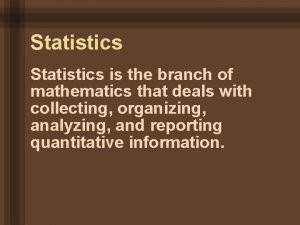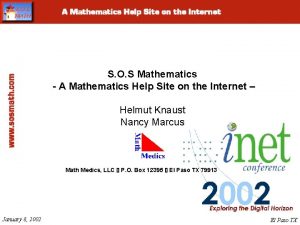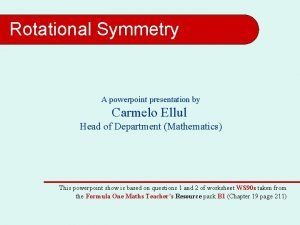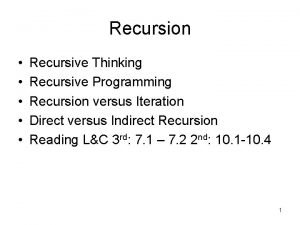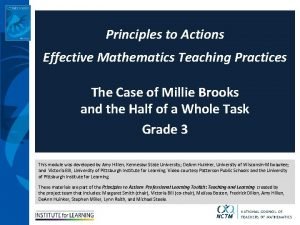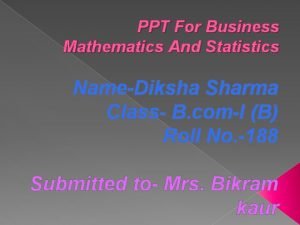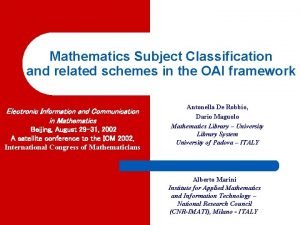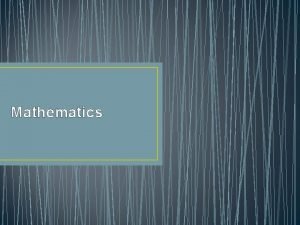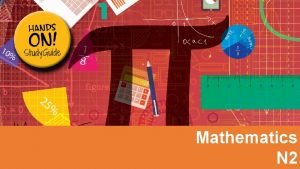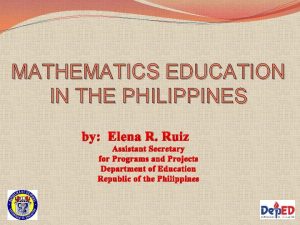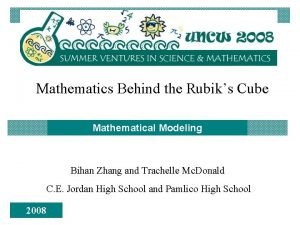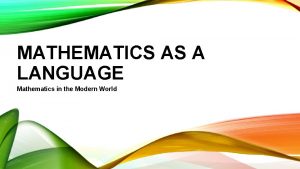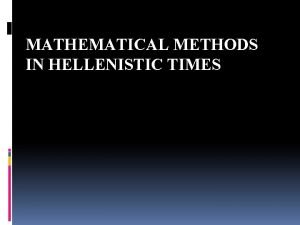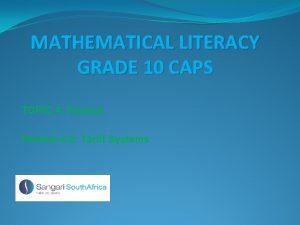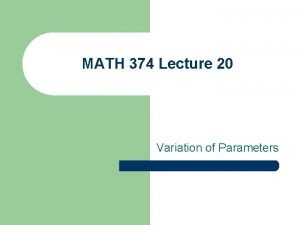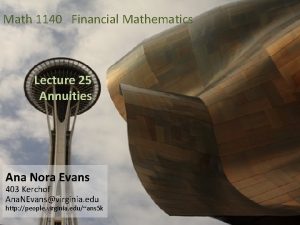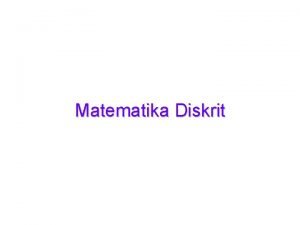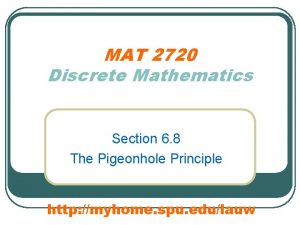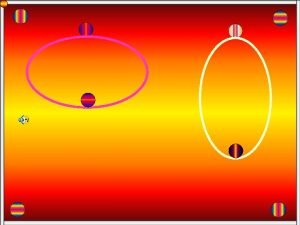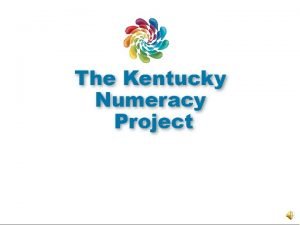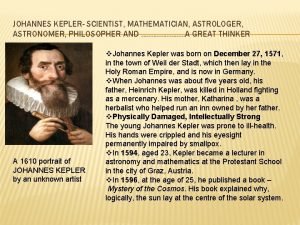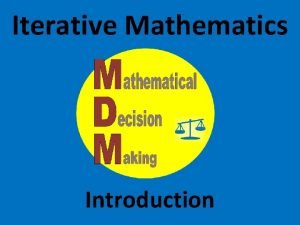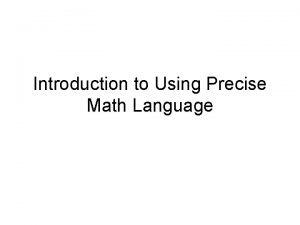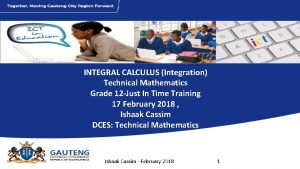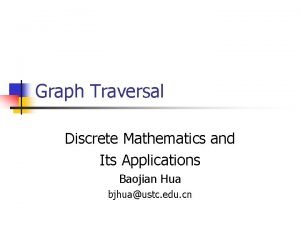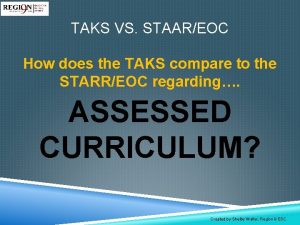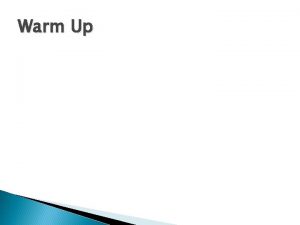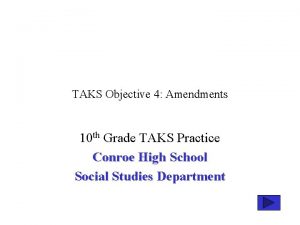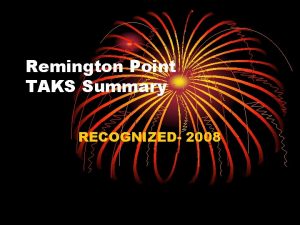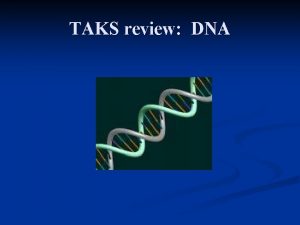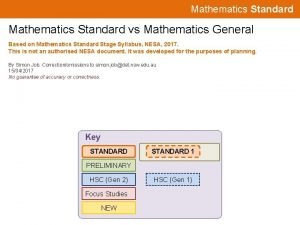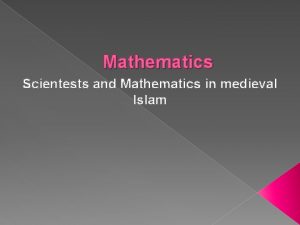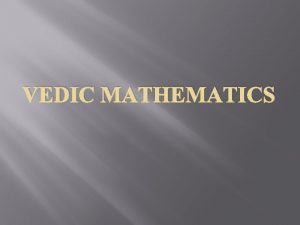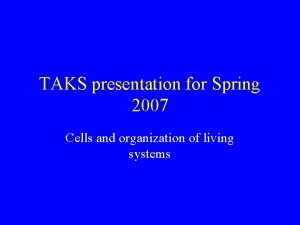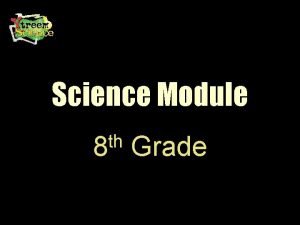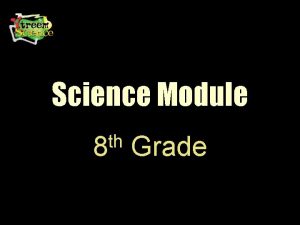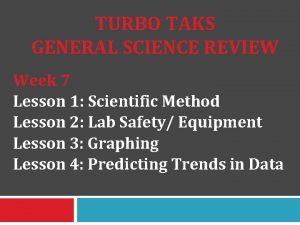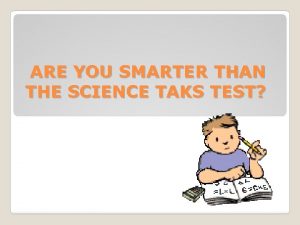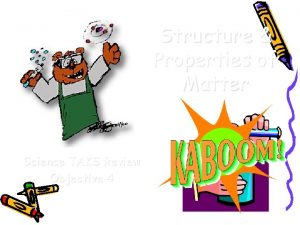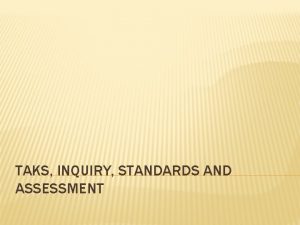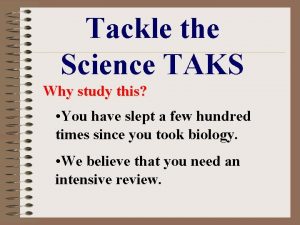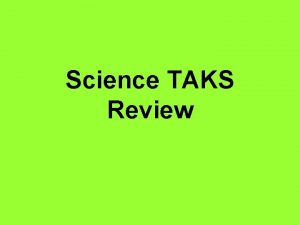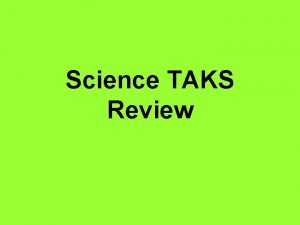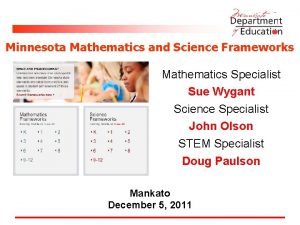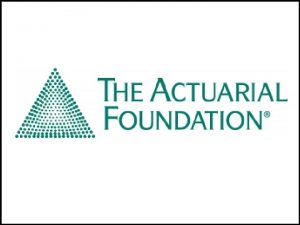TAKS 2007 Performance Mathematics TAKS 2007 Performance Science






























































- Slides: 62


TAKS 2007 Performance Mathematics

TAKS 2007 Performance Science

TAKS 2007 Performance Reading/English Language Arts

TAKS 2007 Performance Writing

TAKS 2007 Performance Social Studies

What is our Goal? • To improve student proficiency in Math and Science In order to accomplish this goal, we must be one united system. Not individual islands.

Benefits of Curriculum Alignment • • Ensure Equity Rational System Alignment makes education in Llano a system Alignment reduces and refocuses teacher planning time. • Alignment reduces the time teachers spend trying to define what the TEKS mean • Alignment reduces gaps and unproductive redundancies • Alignment allows us to work smarter

Guaranteed Viable Curriculum • • • New TEKS New tests New standards New teachers New graduation plans • Time is right for new curriculum.

Student Learning Issues • Missing learning • Incomplete learning • Inaccurate learning • Competing learning

Education: Blueprint to the Future • By 2040, Texas will see a 75% increase in the number of children in our public schools. • If our schools are unable to keep pace with the needs of students today, our labor force in 2040 will be less well-educated, but we will live in a more technologically sophisticated society and international community than we live in today. • A rigorous, relevant curriculum for all students is an important factor for the short and long term health of our state and our society.

Guiding Questions 1. When you look at your data, what does it tell you? - What about the district’s curriculum? - Whose responsibility is it? 2. Is the curriculum being implemented in every classroom? - Whose responsibility is this? 3. At what quality level is the curriculum being delivered? -Whose responsibility is this?

The School Factors • • • Guaranteed and viable curriculum Challenging goals and effective feedback Parent and community involvement Safe and orderly environment Collegiality and professionalism Robert Marzano, What Works in Schools

Guaranteed Viable Curriculum • Opportunity to Learn – If students do not have the opportunity to learn the content expected of them, there is little chance that they will. • Time – Given the massive amount of content to be taught, we don’t have time in our busy school calendars for redundancies.

Marzano’s Action Steps 1. 2. 3. 4. 5. Identify & communicate the essential content for all students Ensure that the essential content can be addressed in the amount of time available for instruction Sequence and organize the content to provide ample opportunity to learn Ensure teachers address the essential content Protect the instructional time available

CSCOPE • Developed by the system of ESCs with content area expert writers and developers • Online system that is customizable to your district needs • Affordable • Curriculum – Assessment – Instruction – Professional Development

ESC Development Team

Research Base • Curriculum Design, Standards, Instructional Design – – – – Robert Marzano Fenwick English Grant Wiggins and Jay Mc. Tighe Heidi Hayes Jacobs John Crain James Barufaldi H. Lynn Erickson • Learning Theory – Reuven Feurstein – Lev Vegotsky • Professional Development – Thomas Guskey – Linda Hammond

What is curriculum all about? How Why What

Difference Between Curriculum and Instruction (Crane) • What – The stuff – The content standard – Knowledge and skills • Why – What we want the kids to do with the stuff – The performance standard • How – Instruction component – How do we design instructional activities so that students learn the stuff and are able to perform at the level indicated in the performance indicator?

What is negotiable in the process? • The “What” is NON-NEGOTIABLE. • The “Why” is NON-NEGOTIABLE. • The “How” is negotiable within limits: – Children learn what they are supposed to learn. – Everyone is treated with courtesy and respect. – Paint generally stays on the walls. – Tiered by teacher developmental level. (Crane)

Slack in the System (Fenwick English) SLACK is the presence of “space” within the three elements of quality control that creates ambiguity and erodes a tight linkage between the three elements Requires CENTRALIZED TESTING CENTRALIZED CURRICULUM TIGHT FIT (no slack)

TEKS and the Curriculum • So, do the TEKS provide all that we need to know in order to create a guaranteed viable curriculum? • Can the TEKS be the curriculum? • Can a textbook be the curriculum? • Can a program be the curriculum? • Would a first year teacher know what to teach from just looking at the TEKS? • Do the TEKS alone tell us how they will be tested on TAKS?

TEKS • The TEKS are a framework for curriculum development. They were NEVER intended to be the curriculum. • The TEKS lack specificity. • The TEKS are not sequenced into units of instruction • TEKS statements have including and such as statements for a few TEKS.

3 rd Grade ELA 105 Student Expectations *Unique Examples

5 th Grade Science 39 Student Expectations *Unique Examples

6 th Grade Math 35 Student Expectations *Unique Examples

ELA and Punctuation • What should be taught if the TEKS said … – 1 st Grade-Use basic punctuation. – 4 th Grade-Punctuate correctly to clarify and enhance meaning. – 8 th Grade-Punctuate correctly to clarify and enhance meaning.

Punctuation Marks • Period (2 rules) • Question mark (3 rules) • Comma (23 rules) • Colon (4 rules) • Semicolon (6 rules) • Apostrophe (2 rules) • Quotation marks (9 rules) • Hyphen (7 rules) • Dash (4 rules) • Parentheses • Brackets • Ellipsis dots

Science TEKS Science Concepts • 2 nd Grade – 2. 9(A) identify the external characteristics of different kinds of plants and animals that allow their needs to be met; • 3 rd Grade – 3. 9(A) observe and identify characteristics among species that allow each to survive and reproduce; • 4 th Grade – 4. 8(A) identify characteristics that allow members within a species to survive and reproduce

Considerations • If these are the TEKS, would a teacher know what he/she is supposed to teach and what students are supposed to learn? • Would an assessment-item writer be able to construct an item that would align with the taught curriculum?

TEKS-Science with specificity 2. 9 A Identify the external characteristics of different kinds of plants and animals that allow their needs to be met. Animal characteristics include: • Types of mouths • Ways to move • Outer coverings Plant characteristics include: • Root length • Leaf type • Stem type • Seed type 3. 9 A Observe and identify characteristics among species that allow each to survive and reproduce. Including: • Bird beak and feet • Skin coloration • Thorns on plants • Waxy skin on desert plants • Gills in fish • Regeneration 4. 8 A Identify characteristics that allow members within a species to survive and reproduce. Animals including: • Body parts • Body coverings • Camouflage • Mimicry • Defense mechanisms against predators and climate Plants including: • Size and pattern of plant root system • Size and shape of leaves • Seed dispersal

True Alignment • Every student expectation should have an including statement. – We need the specificity to be sure that everyone understands their responsibilities in the TEKS and gets to the heart of the curriculum for student learning.

CSCOPE Components • Vertical Alignment Documents – Specificity for each Student Expectation • Year at a Glance • Instructional Focus Documents – Six weeks bundles that organize the specified student expectations into logical units • Units of Study – Overview of learning that include standards, – Rationale, lessons, misconceptions and much more

CSCOPE Components • Lessons – Stand-alone, state developed, customized district lessons – all built on research based lesson design • Lesson Planner • TEKS Verification Matrix • Unit Tests – Common assessments including items in TAKS format for each six weeks • Statewide professional development • Customized professional development

Vertical Alignment Documents • Assure equity • Backload tested standards • Reduce gaps and unproductive redundancies – Love Units

Vertical Alignment Documents

Year at a Glance • Organize TEKS by six or nine weeks • Organize Units of Study

Instructional Focus Documents • The TEKS are not organized for instructional delivery. – Arranged in strands, NOT coherent units of instruction – Not arranged on a time-line • Instructional Focus Documents place TEKS in a coherent, rational sequence of instruction – Indicate the TEKS and the specificity that will be addressed in the instructional unit – Refocus teacher planning time – Ensure learning to performance indicators – Provide rationale

Instructional Focus Documents

Units of Study • Built around instructional sequence • Performance Indicators • Free of commercial products and not tied to a particular textbook • Add/adapt/change the learning experiences as long as students can perform at a rigorous level • Provide examples of the How

Units of Study • Key Elements – – – – – Concepts Key Understandings and Guiding Questions Specified TEKS Performance Indicators Sequence of Lesson Activities Reference to State Lessons Customizable District Lessons Key Content, Skills, Materials, Vocabulary Misconceptions

Instructional Focus Instructional Development TEKS “Unpack” Content Concept Skills Curriculum Framework SEQUENCED Sequence Topics Instructional Delivery Sequenced Plan of Learning Activities (Unit) Unit Map TEKS Embed Concepts Key Understandings Excite Concepts & Key Understandings Draft Performance Indicators Performance Continuum Explore Explain Extend Performance Indicators Extend

Lessons • Built on the 5 E Model – Engage – Explore – Explain – Extend/Elaborate – Evaluate

Lessons

More Lessons • State Lessons • District Lessons • Make it yours!

Other CSCOPE Components • TEKS Verification Matrix • Unit Tests – Common assessments including items in TAKS format for each six weeks • Statewide professional development • Customized professional development

Teacher Level of Development • Experienced AND Successful (VAD, IFD, Assessment) • Experienced BUT Struggling • New to grade level • New to profession VAD IFD Units Lessons Assessments

Online Curriculum Management System

Online System - NER • Web-Based Curriculum Management System (Housing mechanism) • Operational 24/7 - Technical Support via the phone or the Internet • Partnership with National Education Resources for over a decade

• • District Curriculum hosted online Domain name registration Unlimited number of users The ability to share units, daily lessons and rubrics with other districts using the service


Pricing Structure • Online System • System Support • Additional Professional Development

ESC XIII Commitment • Provide full access to the CSCOPE Curriculum System. • Provide training for designated district curriculum leaders on the operations and implementation of the system. • Coordinate with NER service providers on end-user issues. • Provide consultation and technical assistance. • Provide eight (8) days professional development on the implementation of the system onsite and or in cluster sites • Provide quarterly leadership professional development activities • Provide professional development teleconferences and webcasts each six weeks for each grade level. • Ongoing listserv support.

District Commitment • Designate a district contact/representative for coordination purposes • Engage in a preplanning process with ESC staff on implementation sequence • Dedicate staff time to implementation of the curriculum • Provide release time for teachers and principals to participate in staff development activities of the cooperative. • Abide by the terms of the End User License Agreement. • Provide a current listing of all approved district domain names. • Provide ESC with teacher names, grade level course assignments, email addresses. • Provide ESC 13 with one (1) district curriculum user assignment. • Participate in user group meetings

www. cscope. us

Success Stories • Teachers are talking, planning, and collaborating ideas! • Students are engaged in relevant activities and making connections to prior learning. • A wealth of resources provided with lessons • Challenging learning through performance indicators and teachers are beginning to embrace performance indicators • Spiraling of instruction-not just teach once and move on • Provides tremendous support for new teachers and for teachers with new assignments

What are the benefits? • Providing a guaranteed, viable curriculum to teachers • Provide a common language, structure, and process for curriculum development and access • Designed to align the written, the taught, and the tested curriculum into a seamless web

Blueprint for Student Success • CSCOPE – Clearly articulates the expectations of students identified in the TEKS • Concepts and understandings • Performances and products • Instructional delivery – Provides the tools for teachers to teach the TEKS

CSCOPE provides the blueprint for the essential outcome of curriculum… Success for Our Kids.

Contact Ervin Knezek Ervin. knezek@esc 13. txed. net 512. 919. 5453

Math Vertical Alignment • • When: June 6 and 7 Where: Llano Junior High computer labs Time: 9: 00 – 4: 00 Who: Llano and Johnson City
 Moore finance taks
Moore finance taks Her favorite subject is math
Her favorite subject is math Mathematics is the science of quantity
Mathematics is the science of quantity Mathematics for computer science mit
Mathematics for computer science mit Die hard
Die hard International journal of science and mathematics education
International journal of science and mathematics education Mathematics for computer science mit
Mathematics for computer science mit Rowan college of science and mathematics
Rowan college of science and mathematics Social science vs natural science
Social science vs natural science Six branches of science
Six branches of science Natural science vs physical science
Natural science vs physical science Applied science vs pure science
Applied science vs pure science Rapid change
Rapid change Science fusion digital lessons
Science fusion digital lessons Rule of 70 in population growth
Rule of 70 in population growth Windcube lidar
Windcube lidar Soft science definition
Soft science definition Behaviorally anchored rating scales
Behaviorally anchored rating scales Performance appraisal process
Performance appraisal process All performance attributes designated as joint performance
All performance attributes designated as joint performance Mathematics timetable
Mathematics timetable Workkeys applied mathematics level 4 answers
Workkeys applied mathematics level 4 answers Wisconsin math council
Wisconsin math council Where mathematics comes from
Where mathematics comes from Asma past papers
Asma past papers 2009 mathematics standards of learning answers
2009 mathematics standards of learning answers Uil general math practice test
Uil general math practice test What is logic in philosophy
What is logic in philosophy Ib math extended essay
Ib math extended essay Ahmaths
Ahmaths The committee (debates/debate) these questions carefully
The committee (debates/debate) these questions carefully Statistics is a branch of
Statistics is a branch of Mathematics iceberg
Mathematics iceberg Sos mathematics
Sos mathematics Symmetry in nature ppt
Symmetry in nature ppt Recursion in math
Recursion in math Using mathematics and computational thinking
Using mathematics and computational thinking Establish mathematics goals to focus learning
Establish mathematics goals to focus learning Business mathematics and statistics ppt
Business mathematics and statistics ppt Division of academics department of mathematics
Division of academics department of mathematics Mathematics subject classification
Mathematics subject classification Scope of mathematics
Scope of mathematics Mathematics n2 modules
Mathematics n2 modules Problems in mathematics education in the philippines
Problems in mathematics education in the philippines Mathematics behind rubik's cube
Mathematics behind rubik's cube What is language in mathematics in the modern world
What is language in mathematics in the modern world Mathematical methods in hellenistic times
Mathematical methods in hellenistic times Mathematical literacy finance
Mathematical literacy finance Variation in mathematics
Variation in mathematics Forborne annuity
Forborne annuity Rosen discrete mathematics solutions
Rosen discrete mathematics solutions Pigeonhole principle in discrete mathematics
Pigeonhole principle in discrete mathematics 3 point arc
3 point arc Uses sophisticated mathematics
Uses sophisticated mathematics Absorption law
Absorption law Logical form and logical equivalence
Logical form and logical equivalence Kentucky center of mathematics
Kentucky center of mathematics Johannes kepler contribution to mathematics
Johannes kepler contribution to mathematics Iterative math
Iterative math The language of mathematics is precise example
The language of mathematics is precise example Grade 12 integration
Grade 12 integration Graph traversal in discrete mathematics
Graph traversal in discrete mathematics Math portfolio examples
Math portfolio examples
